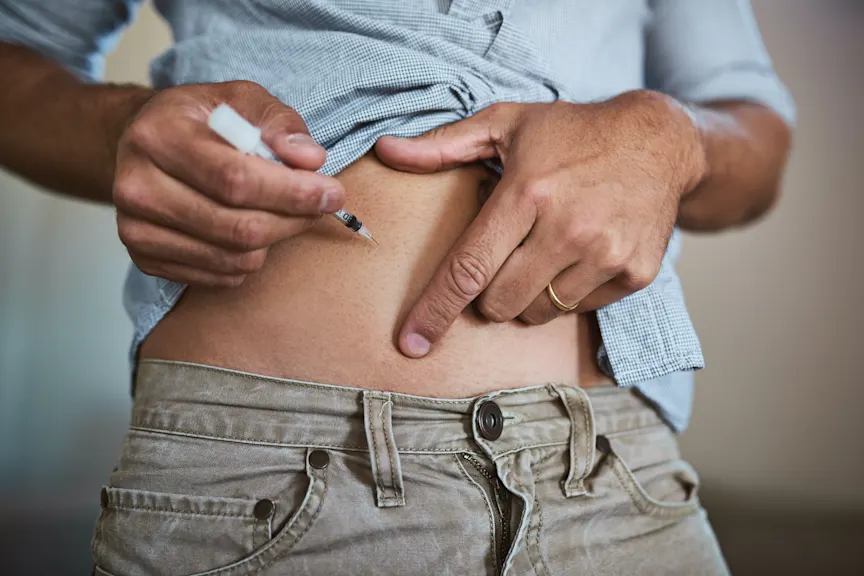How to Overcome Self-Injection Anxiety
Some of us fear needles, others the notion of giving a shot to ourselves. Here’s how to get over every self-jab hurdle.

Sharp needles andself-injections are a fact of life for people who rely on medication to manage certain chronic health conditions. From inflammatory diseases such as ankylosing spondylitis (AS) and psoriatic arthritis (PsA), to disorders like diabetes that affect blood sugar, all kinds of people self-inject medications every day, including immunosuppressive therapies, insulin, blood clotting treatments, and more.
Though self-injection meds are very common, that doesn't mean they don’t drum up a bit (or a whole lot) of anxiety for some folks. If that’s you, you’re not alone. Here are the reasons why self-injection can cause duress—and what you can do about it.
Fear of Needles
Sometimes, the idea of needing medication is emotionally jarring; it can take time to process that a.) you have a chronic condition and b.) it requires treatment.
But beyond the complex emotions associated with diagnosis and starting a new drug regimen, people (especially those in the chronic illness community, according to theJournal of Advanced Nursing) often find that needles, well, just plain freak them out. Up to 10% of the general population has a fear of jabs, starting at about the age of five. And that fear can increase with age. For a lot of people, needle phobia leads to needle avoidance—a real challenge for those who rely on self-injectable meds to manage chronic conditions.
The journalDrug Delivery傻人nd that many people who have to inject themselves with medication have a range of concerns, from worrying about the sting of the needle to wondering, “Am I doing this thing correctly?” And if your chronic condition leaves you with shaking or arthritic hands, all the more so.
Learn How to Self-Inject the Right Way
Before you let needle phobia get the best of you, ask your doctor to set you up with an educator for guidance before going solo, suggests Sapna Shah, M.D., an endocrinologist at Paloma Health in New Hyde Park, NY, who has taught plenty of patients how to inject insulin. For her diabetes patients, “I rely on well-trained diabetes educators to help guide patients and families through the[injection]process,” she adds.
Natasha Thompson, 37, who self-injects biologic drugs to manage her PsA, says that she was uncomfortable with needles until a nurse ambassador helped her: “She walked me through everything and had me practice with a test injector kit. When it came time for the injection, she left it up to me if I wanted her to do it. I sucked it up and did it,” she says. “Having her come out was greatly beneficial because I could make sure I was doing everything correctly.”
Taking your own guided tour of someoneelseself-injecting before you ever try it yourself may help, too.The Clinical Journal of Pain傻人nd that observational learning, a.k.a., watching how others experience the same thing you're about to go through, can curb anxiety.
So how best to bear witness? Go social. Look online to chronic illness community members, who are all too happy to share their injection tips and tricks—and even film their injections for you. Or check out dozens ofinjection videosunder the #InjectWithMe hashtag on TikTok, YouTube, or Instagram. Watching a few of these videos may boost your confidence—and you’ll know you’re not alone.
On Self-Injection Days, Relax
“Deep breathing techniques can help eliminate injection anxiety,” says Dr. Shah. That’s because with each deep, full breath, the brain begins to slow its anxious thought spiral. You’ll notice that your heart rate decreases, your breathing becomes steadier, and your thoughts become more focused. Plus, you can do it anywhere, without equipment and at no cost.
Here’s how, plus a few other relaxation tips:
Belly breathing.Dr. Shah suggests you lie down and place one hand below your ribs while the other rests on your chest. This way, you actually have a visual on your breath moving through your body, working its magic. Breathe in slowly and deeply so that your belly—not your chest—rises. Slowly breath out through your mouth and watch your belly fall. Do this a few times, until you’ve reached a more chilled-out state and are ready to face the needle.
Serene environment.To up the relaxation ante, make sure that wherever you’re giving yourself the shot is clean, calm, and stress-free. (In other words, don’t head for the living room sofa where the dog’s been sleeping as the TV blares in front of the squabbling kids.) Instead, think your favorite chair in your bedroom near a sunlit window.
Right attire.Throw on a comfortable outfit, or a pair of cozy PJs. Go for clothing that allow easy access to the area where you’ll be self-injecting, like your tummy or thigh.
Mellow tunes.Music can also help you get more comfortable, says Dr. Shah. Prior to injection, hit “play” on your favorite playlist—or put on tunes designed to chill you out, like meditation or yoga music. Not only will the music distract you from any icky needle sounds (like the “click” of an auto-injector), they can have a real effect on your mind and body. According to the以证据为基础的综合医学杂志》上, listening to music just before an injection has been shown to decrease anxiety. Interestingly, the journal also found that both binaural beats—which are two different tones played in each ear—and nature sounds, like birds chirping or a river gently flowing, can help do the trick, too.
Try Exposure and Applied Tension Interventions
Observational learning is one thing. Handling the needle yourself is another—and may actually be the best thing you can do to defeat needle phobia in the long run.
Dr. Shah is a fan of something calledexposure therapy, which she finds to be extremely effective among her most needle-phobic patients. It means that you don’t look away from the needle when your doctor or nurse injects you—instead you carefully watch the needle as it pierces your skin, until you're comfortable doing it yourself. It may seem totally counterintuitive, but “the more involved[you are]in the process, the better,” Dr. Shah says. And you don’t have to go from zero to 60 right from the get-go—exposure therapy can happen in baby steps. “Start by holding an empty or full syringe. Then, maybe fill the syringe. Sometimes you can even pretend to inject. The more you go through the process, the more the anxiety is reduced,” she adds.
If you’re mainly worried about pain, one study published inThe European Journal of Pain傻人nd that people lookingat针进入皮肤实际上报道less pain as compared to those who chose to look away. Though researchers don't exactly understand why, watching seems to have a numbing affect
Tension interventionscan help, too, a strategy developed to help prevent needle-phobics from fainting before or after a shot, reports Anxiety Canada. Before you self-inject, try tensing up your muscles in your body, which raises blood pressure. If your blood pressure increases, you are less likely to faint.
Focus on Routine and the Health Benefits
Jerry Drake, 47, of Washington, D.C., self-injects with Ozempic (semaglutide) to help control his blood sugar. He describes the self-shots as initially “terrifying,” and he was super-worried about the unknowns: “What if I caught an air bubble? Would I be able to stand the pain each day? I travel a lot—would I be able to do it on trips?”
Eventually, Drake built the injection into his daily routine. “I injected[daily]in the morning, after coffee, as part of my ritual of watching the news and having breakfast. It felt more routine like shaving, and I didn’t have to think about it.”
Ultimately, he says, he focuses on the good the medicine is doing for him. “What has made it easier is the results I get from the drug,” he adds. “It controls my blood sugar, makes me feel better, and dramatically improves my quality of life.”
Dr. Stuart D. Kaplan M.D., chief of rheumatology at Mount Sinai South Nassau in Hewlett, NY, agrees that it’s helpful to remind yourself how these drugs are designed to simplify and improve your life. “Some drugs are done intravenously in the office, and[that]can take from 30 mins to two hours,” says Dr. Kaplan. “But nowadays, most are[by]automatic injection so you don’t have to go to your doctor’s office, and you don’t even to press the syringe, which make it a lot easier.”
Pick a time when it’s easy to build the injection into your daily routine, advises Dr. Shah. Is it before bed, or early in the morning? Talk to your doctor about the best time to take your medication, and bookend it with your other normal activities.
Temperature Control
Ensure a smooth injection experience by making sure your skin is clean and ready to go. Be sure to wash your hands and carefully sterilize the area you’ll be jabbing (clean it with alcohol, and then let it dry for 20 seconds) to avoid any bacteria getting into the injection site. You’ll also want to rotate your inject sites, too—say, from tummy to the leg—so the previous jab spot gets a chance to heal.
Some medications are kept in the refrigerator and feel better when injected at room-temp, Dr. Shah says. “If medically appropriate, sometimes keeping the medication at room temperature for a little bit prior to injecting can reduce the sting,” she explains.
You can also use some ice before the shot to numb the area a bit beforehand.
Still Freaking? Ask for Help
If you’re still nervous about self-injecting, sending out an SOS is totally OK!
First, take advantage of anypatient education programsavailable, which might be offered by your local hospital or through your medication’s manufacturer. These programs can teach you how the medicine works, what to expect when you take it, and how to self-inject properly. Some even offer a support contact. You can also connect with other patients through online health communities, Dr. Shah recommends. Sites likeHealth UnionorWEGO Healthoffer robust patient connection platforms where people share tips and tricks about their conditions, including their injection experiences.
In the end, battling your needle phobia may not be easy, but it is doable. You’ve got this!
Self-Injection and Well-Being:Health and Quality of Life Outcomes. (2018.) “Assessing patients’ acceptance of their medication to reveal unmet needs: results from a large multi-diseases study using a patient online community.”https://www.ncbi.nlm.nih.gov/pmc/articles/PMC6034222/
Chronic Conditions and Needle Anxiety:Journal of Advanced Nursing. (2019.) “The fear of needles: A systematic review and meta-analysis.”https://pubmed.ncbi.nlm.nih.gov/30109720/
Needle Anxiety:Sage Open Nursing. (2018.) “Fear of Injections and Needle Phobia Among Children and Adolescents: An Overview of Psychological, Behavioral, and Contextual Factors.”https://journals.sagepub.com/doi/full/10.1177/2377960818759442
Injection Fear:Drug Delivery. (2019.) “A portfolio of biologic self-injection devices in rheumatology: how patient involvement in device design can improve treatment experience.”https://www.ncbi.nlm.nih.gov/pmc/articles/PMC6442222/
Music and Self-Injection:以证据为基础的综合医学杂志》上. (2021). “Meditation Monologue can Reduce Clinical Injection-Related Anxiety: Randomized Controlled Trial.”https://journals.sagepub.com/doi/pdf/10.1177/2515690X211006031





